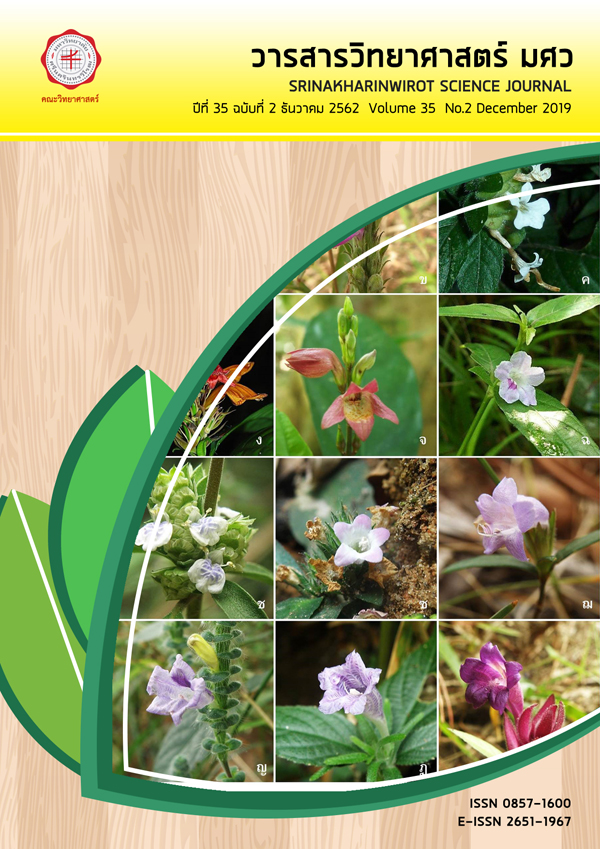Enhancing Bio-Electricity Generation Using Novel Model of Ceramic-Separator Microbial Fuel cell with a Laccase-Based Cathode
Keywords:
Ceramic-separator, Coconut coir, Electrical energy, Laccase, Microbial fuel cell, Stainless steel, SulfateAbstract
บทคัดย่อ เยื่อแลกเปลี่ยนโปรตอนเป็นองค์ประกอบสำคัญที่มีอิทธิพลต่อต้นทุนในการเดินระบบ การบำบัดสารปนเปื้อนในน้ำเสียและการผลิตกระแสไฟฟ้าในเทคโนโลยีเซลล์เชื้อเพลิงจุลินทรีย์ จากการศึกษาที่ผ่านมาวัสดุที่มีรูพรุนหลากหลายชนิดถูกนำมาประยุกต์ใช้ รวมถึงแผ่นเซรามิก ในงานวิจัยนี้เซลล์เชื้อเพลิงจุลินทรีย์เซรามิกรูปแบบใหม่ถูกพัฒนาขึ้น โดยใช้ขั้วแคโทดที่ผิวมีจุลินทรีย์แบบใช้อากาศเคลือบอยู่ซึ่งที่ประกอบขึ้นจากการเพาะเลี้ยงเชื้อยีสต์ Galactomyces reessii ที่ผลิตแลคเคสบนวัสดุใยมะพร้าวและวางบนแผ่นตาข่ายสเตนเลส ใช้ผ้าคาร์บอนเป็นขั้วแอโนด และใช้แผ่นเซรามิกที่มีความหนา 0.2 เซนติเมตร เป็นแผ่นกั้นประจุ ใช้น้ำเสียยางพาราที่มีความเข้มข้นซัลเฟตเริ่มต้นที่ 500 มิลลิกรัมต่อลิตร และค่าซีโอดีเริ่มต้นที่ 1,000 มิลลิกรัมต่อลิตร จากการศึกษาพบว่าระบบเซลล์เชื้อเพลิงจุลินทรีย์เซรามิกรูปแบบใหม่ที่พัฒนาขึ้นซึ่งทำการเดินระบบแบบกะ สามารถผลิตความหนาแน่นกำลังไฟฟ้าสูงสุดที่ 310.78±1.94 มิลลิวัตต์ต่อลูกบาศก์เมตร ความหนาแน่นกระแสไฟฟ้าสูงสุดที่ 3,392.09±16.07 มิลลิแอมแปร์ต่อลูกบาศก์เมตร และมีค่าความต้านทานภายในระบบเท่ากับ 330 โอห์ม ระบบนี้สามารถบำบัดซีโอดีได้ที่ร้อยละ 78.70±0.56 และบำบัดสารซัลเฟตที่ร้อยละ 88.85±0.50 ดังนั้นเซลล์เชื้อเพลิงจุลินทรีย์เซรามิกรูปแบบใหม่มีศักยภาพในการพัฒนาเพื่อใช้ในการบำบัดน้ำเสียในระดับอุตสาหกรรม คำสำคัญ: แผ่นกั้นเซรามิก ใยมะพร้าว พลังงานไฟฟ้า แลคเคส เซลล์เชื้อเพลิงจุลินทรีย์ สแตนเลส ซัลเฟต ABSTRACT In microbial fuel cell (MFC), a proton exchange membrane (PEM) is an important part that affects the cost of the operation and the performance in contaminants elimination and electricity production. Various types of porous materials have been studied as alternatives to ion separators including ceramic. In this work, a novel model of ceramic-separator microbial fuel cell (CMFC) consisted of air-cathode based on coconut coir with laccase producing yeast Galactomyces reessii on stainless steel net, the carbon cloth anode and ceramic plate with 0.2 cm of thickness. The rubber wastewater (initial 500 mg/L sulfate concentration and 1,000 mg/L COD concentration) was used as an anolyte. The maximum power density of 310.78 ± 1.94 mW/m3, the maximum current density of 3,392.09 ± 16.07 mA/m3 and the internal resistance of 330 Ω were obtained for CMFC by laccase-based cathode under batch processing. Moreover, the COD removal of 78.70 ± 0.56% and the sulfate removal of 88.85 ± 0.50% were achieved. Hence, the ceramic-separator microbial fuel cell with a laccase-based cathode are potential candidate for the development of industrial-scale wastewater treatment plants.Keywords: Ceramic-separator, Coconut coir, Electrical energy, Laccase, Microbial fuel cell, Stainless steel, SulfateDownloads
Download data is not yet available.
Downloads
Published
2019-08-31
How to Cite
Chaijak, P., Sato, C., Sukkasem, C., Lertworapreecha, M., Boonsawang, P., & Paucar, N. E. (2019). Enhancing Bio-Electricity Generation Using Novel Model of Ceramic-Separator Microbial Fuel cell with a Laccase-Based Cathode. Science Essence Journal, 35(2), 123–136. Retrieved from https://ejournals.swu.ac.th/index.php/sej/article/view/11255
Issue
Section
Research Article








